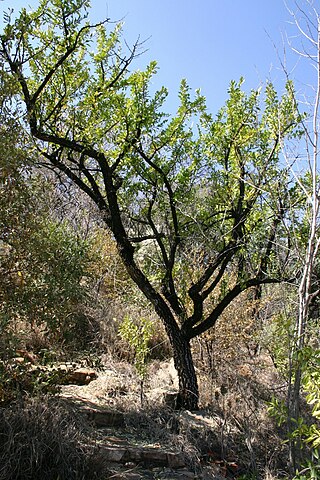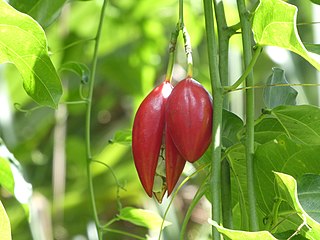
Araucaria heterophylla is a species of conifer. As its vernacular name Norfolk Island pine implies, the tree is endemic to Norfolk Island, an external territory of Australia located in the Pacific Ocean between New Zealand and New Caledonia. It is not a true pine, which belong to the genus Pinus in the family Pinaceae, but instead is a member of the genus Araucaria, in the family Araucariaceae, which also contains the monkey-puzzle tree. Members of Araucaria occur across the South Pacific, especially concentrated in New Caledonia where 13 closely related and similar-appearing species are found. It is sometimes called a star pine, Polynesian pine, triangle tree or living Christmas tree, due to its symmetrical shape as a sapling.

Collinsia heterophylla, known as purple Chinese houses or innocence, is a flowering plant native to California and the Peninsular Ranges in northern Baja California.

Tsuga heterophylla, the western hemlock or western hemlock-spruce, is a species of hemlock native to the west coast of North America, with its northwestern limit on the Kenai Peninsula, Alaska, and its southeastern limit in northern Sonoma County, California. The Latin species name means 'variable leaves'.

Euphorbia heterophylla, also known under the common names of (Mexican) fireplant, painted euphorbia, Japanese poinsettia, desert poinsettia, wild poinsettia, fire on the mountain, paintedleaf, painted spurge, milkweed, and kaliko plant, is a plant belonging to the Euphorbiaceae or spurge family.

Carica is a genus of flowering plants in the family Caricaceae including the papaya, a widely cultivated fruit tree native to the American tropics.

Acacia heterophylla, the highland tamarind, is a tree endemic to Réunion island where it is commonly named tamarin des hauts The tree has a juvenile stage where its leaves have a pinnate arrangement, but in the adult stage the leaves diminish and the phyllode becomes the dominant photosynthetic structure.

Corylus heterophylla, the Asian hazel, is a species of hazel native to eastern Asia in northern and central China, Korea, Japan, and southeastern Siberia.

Salmo-Priest Wilderness is a 41,335 acre (167.28 km2) wilderness area located in the Selkirk Mountains in the northeast corner of Washington state, within the Colville National Forest and the Kaniksu National Forest.

Gymnosporia heterophylla, the common spike-thorn, is a small, hardy, deciduous African tree up to 5m tall, occurring in rocky places with a wide distribution from Ethiopia, the Sudan and the Congo, south to the Cape Province and west to Angola and Namibia, as well as the neighbouring islands of Madagascar and Saint Helena, with a closely related species from Mauritius.

Garberia is a monotypic genus of flowering plants in the family Asteraceae, containing the single species Garberia heterophylla. It is endemic to Florida in the United States, where it is distributed in the northern and central counties. The plant is known commonly as garberia and Garber's scrub starts.

Drosera heterophylla, the swamp rainbow, is an erect perennial tuberous species in the carnivorous plant genus Drosera that is endemic to Western Australia. It grows in shallow water swamps or wet clay flats near granite outcrops and occurs in the vicinity of Perth and to its north. D. heterophylla produces small leaves along an erect stem that can be 10–30 cm (4–12 in) tall. It is the only species in the genus that produces many-petaled flowers. These white flowers emerge from June to September.

Iostephane is a genus of Mexican flowering plants in the family Asteraceae.

Agoseris heterophylla is a liguliferous species in the family Asteraceae known by the common name annual agoseris or mountain dandelion. It is widespread in mostly drier regions of western North America from British Columbia to Baja California.

Populus heterophylla, also known as downy poplar, swamp poplar and swamp cottonwood, is a large deciduous poplar belonging to the Populus genus of the family Salicaceae. This species can grow on sites that have too much water for other native poplars. On the IUCN Red List this species is listed as "least concern".

Billardiera heterophylla is a species of flowering plant in the family Pittosporaceae, known by the common name bluebell creeper. It is native to Western Australia, but is grown as an ornamental plant in appropriate climates worldwide. It can sometimes be found growing in the wild as an introduced species or garden escapee, for example in other Australian states and in California, where it is popular in landscaping. It is sometimes considered a weed.

Mariosousa heterophylla, also called the palo blanco tree, palo liso, guinola, and Willard acacia, is a normally evergreen mimosoid plant in the genus Mariosousa native to Mexico. The Spanish common name translates into 'white stick', defining its peeling white bark. A compound called willardiine, that acts as an agonist in glutamate receptors, can be isolated from M. heterophylla.

Opisthiolepis is a genus of a sole described species of large trees, constituting part of the plant family Proteaceae. The species Opisthiolepis heterophylla most commonly has the names of blush silky oak, pink silky oak, brown silky oak and drunk rabbit.

Ficus heterophylla is a fig plant species, in the family Moraceae, which can be found in India, southern China, Indo-China and western Malesia. In Vietnam it may be called vú bò.

Alocasia heterophylla is a plant in the family Araceae. It is endemic to the islands of Luzon, Mindanao, and Polillo in the Philippines.

Adenia heterophylla, commonly known in Australia as the lacewing vine, is a climbing plant in the family Passifloraceae. It has a broad distribution spanning the equator, from the south eastern corner of China, through Indochina and Malesia, to northern Australia. In Australia it serves as a food plant for larvae of the glasswing, red lacewing and cruiser butterflies.




















